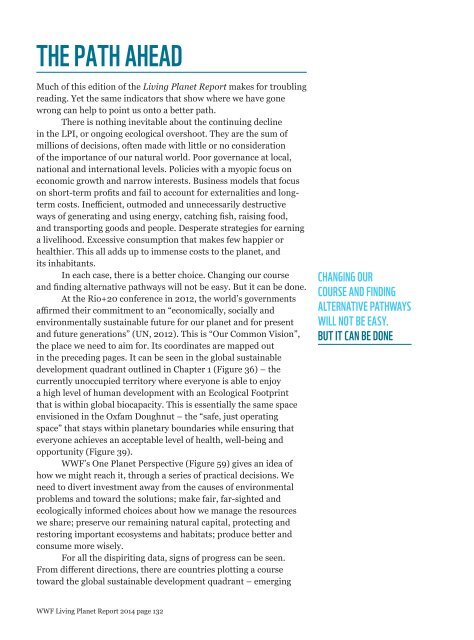5nvGuh
5nvGuh
5nvGuh
You also want an ePaper? Increase the reach of your titles
YUMPU automatically turns print PDFs into web optimized ePapers that Google loves.
THE PATH AHEADMuch of this edition of the Living Planet Report makes for troublingreading. Yet the same indicators that show where we have gonewrong can help to point us onto a better path.There is nothing inevitable about the continuing declinein the LPI, or ongoing ecological overshoot. They are the sum ofmillions of decisions, often made with little or no considerationof the importance of our natural world. Poor governance at local,national and international levels. Policies with a myopic focus oneconomic growth and narrow interests. Business models that focusand transporting goods and people. Desperate strategies for earninga livelihood. Excessive consumption that makes few happier orhealthier. This all adds up to immense costs to the planet, andits inhabitants.In each case, there is a better choice. Changing our courseAt the Rio+20 conference in 2012, the world’s governmentsenvironmentally sustainable future for our planet and for presentand future generations” (UN, 2012). This is “Our Common Vision”,the place we need to aim for. Its coordinates are mapped outin the preceding pages. It can be seen in the global sustainabledevelopment quadrant outlined in Chapter 1 (Figure 36) – thecurrently unoccupied territory where everyone is able to enjoya high level of human development with an Ecological Footprintthat is within global biocapacity. This is essentially the same spaceenvisioned in the Oxfam Doughnut – the “safe, just operatingspace” that stays within planetary boundaries while ensuring thateveryone achieves an acceptable level of health, well-being andopportunity (Figure 39).WWF’s One Planet Perspective (Figure 59) gives an idea ofhow we might reach it, through a series of practical decisions. Weneed to divert investment away from the causes of environmentalproblems and toward the solutions; make fair, far-sighted andecologically informed choices about how we manage the resourceswe share; preserve our remaining natural capital, protecting andrestoring important ecosystems and habitats; produce better andconsume more wisely.For all the dispiriting data, signs of progress can be seen.toward the global sustainable development quadrant – emergingCHANGING OURCOURSE AND FINDINGALTERNATIVE PATHWAYSWILL NOT BE EASY.BUT IT CAN BE DONEWWF Living Planet Report 2014 page 132


